Score - Dog Man’s Score Unleashed: Tom Howe on Crime Thrillers, Funk & Creativity
By Mulder, Los Angeles, 14 february 2025
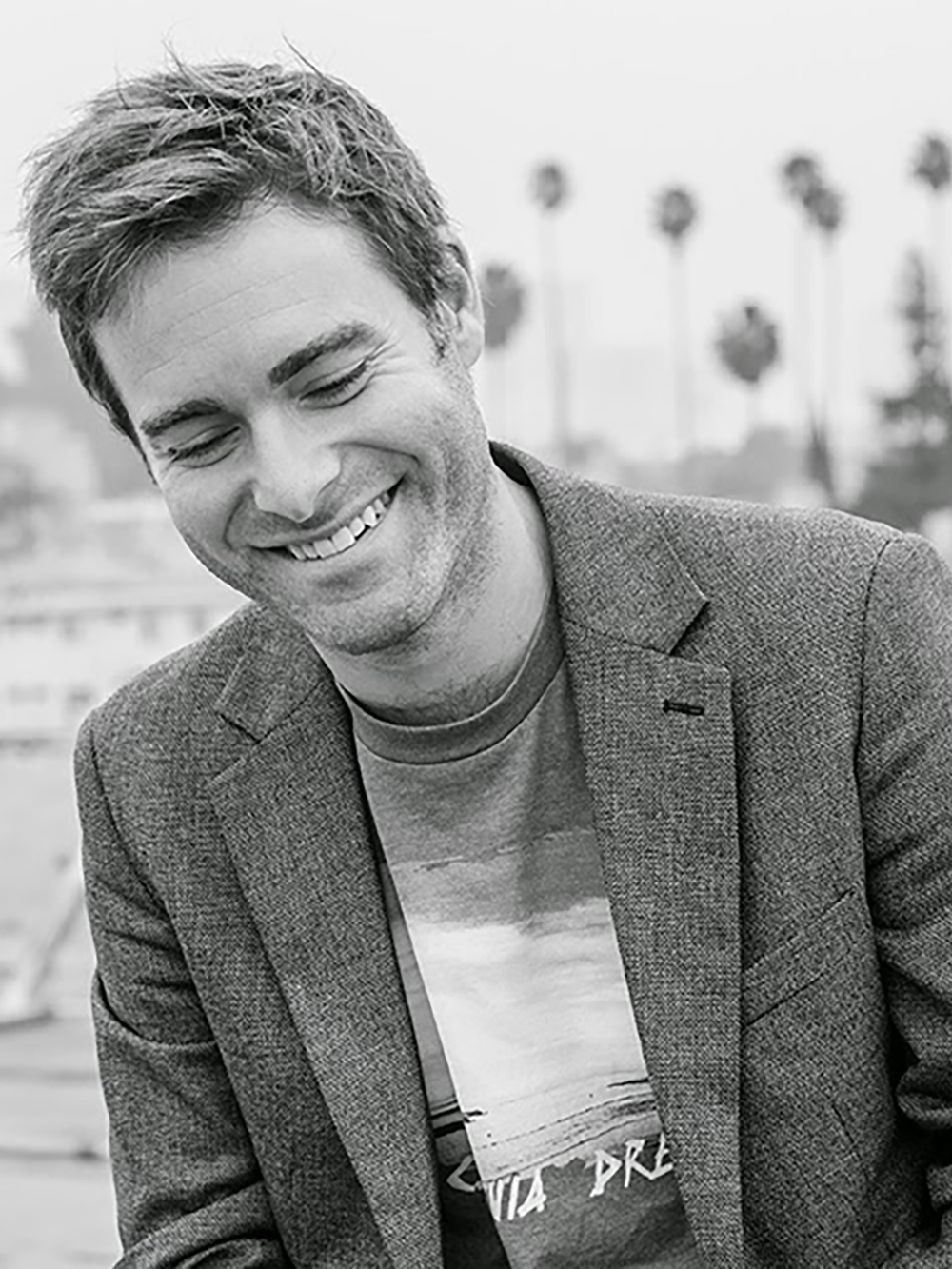
DreamWorks Animation’s Dog Man brings Dav Pilkey’s beloved graphic novel series to life in a vibrant and action-packed adaptation filled with slapstick humor and heart. Directed by Peter Hastings, the film captures the essence of Pilkey’s quirky storytelling, following the adventures of Dog Man, a half-dog, half-human hero who fights crime with an unwavering sense of justice and boundless energy. With a mix of frenetic action, playful comedy, and touching emotional moments, Dog Man is a visually dynamic and wildly entertaining experience. The film's unique animation style, coupled with its witty narrative and an unforgettable soundtrack, has already garnered positive reviews, making it a standout in DreamWorks' impressive lineup.
At the heart of Dog Man's lively and unpredictable atmosphere is its dynamic musical score, crafted by award-winning composer Tom Howe. Known for his genre-blending compositions, Howe infused the film with a rich sonic landscape that mirrors its energy and eccentricity. Tasked with giving voice to a protagonist who doesn’t speak, Howe experimented with unconventional instrumentation, layering funky brass, percussive hand claps, and playful sound effects to create a score that feels as animated as the visuals. His inspiration from ’60s and ’70s crime thrillers, combined with modern funk and orchestral elements, results in a soundtrack that not only amplifies the action but also deepens the emotional core of the story. Whether through the pulsating rhythms of the chase sequences or the soulful warmth of more tender moments, Howe’s score ensures that Dog Man is an immersive experience—one that resonates long after the credits roll.
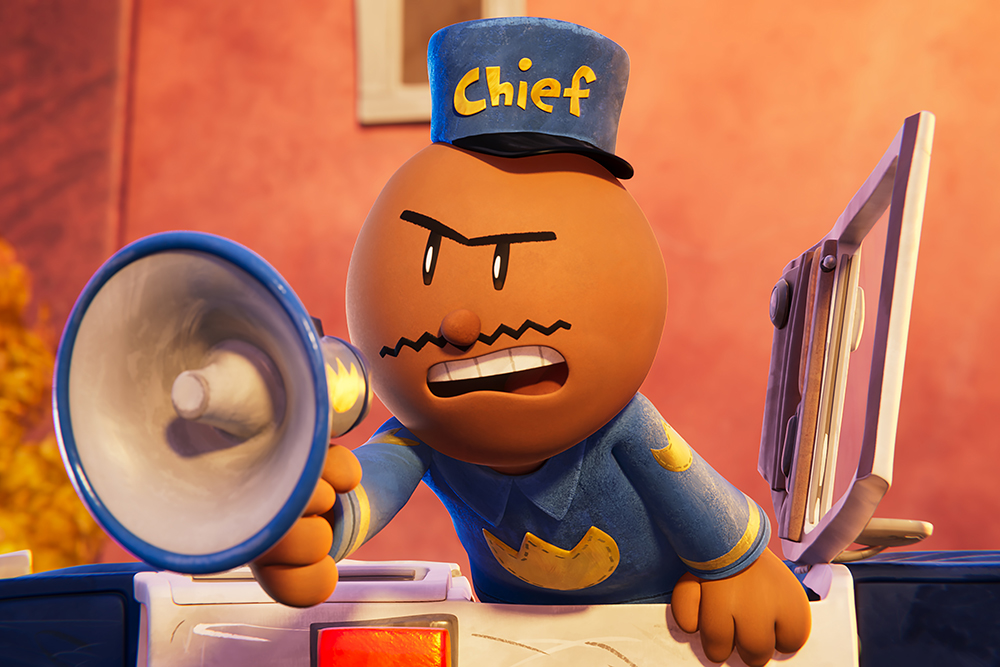
Q: Dog Man is such a unique concept, blending humor, action, and heart. How did you approach creating a musical identity for a character that is both part dog and part human ?
Tom Howe: Yeah, well, I spent a lot of time with the director, Peter Hastings, who is also a very good musician, and we spent a lot of time talking about what the sound of the movie would be. What makes this a little bit unique is that many of the characters have their own themes—which is not unusual—but the sound palette surrounding those characters is quite different, certainly in the first half of the movie.
So, for Dog Man, he has what I’m calling a mouth trumpet, which was originally an idea played on a kazoo. But the kazoos felt a bit brash and in-your-face, and we felt that had been done before. So instead, it became just singing with your mouth closed for Dog Man, along with panting sounds—just me breathing heavily into the mic very rhythmically—combined with electric guitars, big band sounds, and that kind of thing. As the film progresses, the orchestra starts joining in more and more, until, in the last 20 minutes of the movie, the orchestra has essentially taken the lead. At that point, those themes are being played within the orchestra, and hopefully, you’ve absorbed them from earlier on in the movie in their different forms.
Q: The film has a mix of crime thriller elements and playful chaos. How did you balance these contrasting tones in your score ?
Tom Howe: Well, really, through the use of themes. For instance, there’s a cue—well, the Big Jump cue, which is the second track on the record—where you hear the spy theme right at the very start. It’s played in quite a grand way; it’s when he comes up out of the sewer in his car and lands, and you hear it played there.
Then, in the next cue, which is called Bomb Squad, about 15 or 20 seconds into it, you hear the same theme, but this time it’s played on upright bass with alto flutes and pianos. It takes on a very 70s Mancini- or Legrand-type vibe. By keeping those themes as a constant—even as the music becomes more epic later—you still recognize them.
A good example is the Lil’ Petey theme. The best use of it is in a cue called Abandoned, where you hear it in its long form—just solo piano and string quartet. But then, in the final showdown, you hear it again, now sung by a choir with full orchestration. I find that if you establish the themes early on with specific colors for those sounds, as long as you keep using them later so that they remain familiar, you can evolve the score by introducing different instrumentation and shifting styles—without it ever feeling too chaotic.
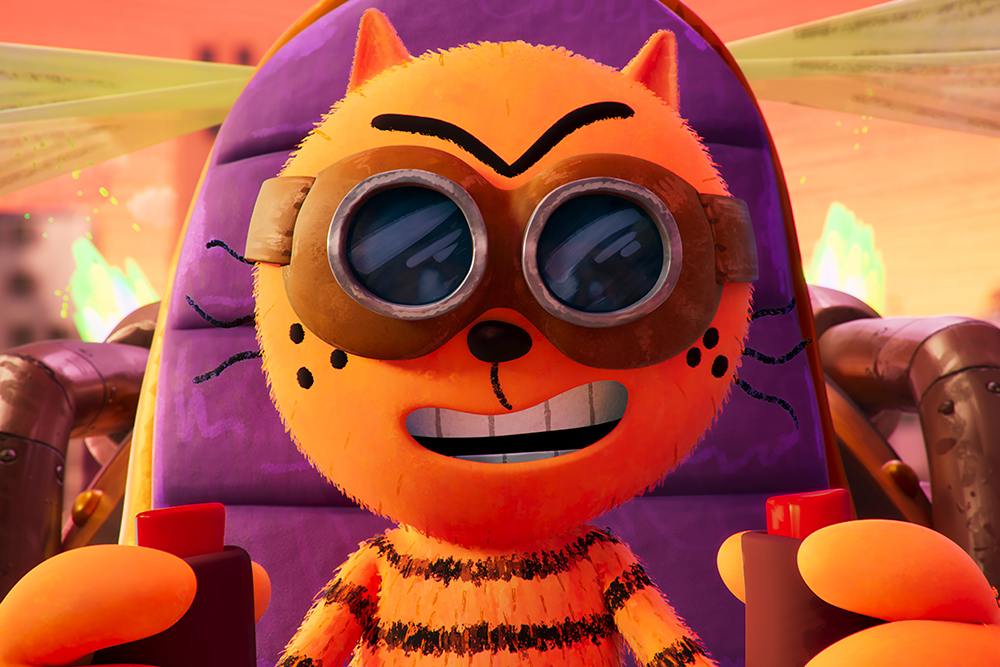
Q: You’ve used inventive instrumentation like hand claps, funky brass, and vocalized sound effects in Dog Man. Can you talk about your decision to incorporate these elements ?
Tom Howe: Yeah, I think that—I mean, starting off on the score, it was just a blank canvas. There was no temp music, so it was just a time for experimentation. I just tried lots of different ideas, and those ones—like the hand claps and things—just stuck around because I liked the feel of them. Also, they work from the beginning of the movie. The first 10 minutes are sort of attempting to ape the 1970s, and some of those sounds are just from that era, so they just worked and stayed within.
I find animation works best when you try and play everything very seriously. So even though the car chase in the opening sequence is, you know, a dog and a policeman talking to each other and avoiding boxes full of the letter B—and it's all ridiculous—I played it as if it were Steve McQueen in Bullitt. Musically, there's no difference in approach; you could take that music and put it in another film from that era, and it would work in the same way. As for those elements, like the dog sounds, finger snaps, and claps, they’re just authentic to some of the styles I was trying to ape, really. So I incorporated them like that and just built a huge palette to work from.
Q: Did you take inspiration from classic crime thriller scores for Dog Man? If so, which composers or films influenced your approach ?
Tom Howe: Well, my favorite film composer of all time is Ennio Morricone. I wasn’t directly influenced by him as such, but there is a sort of Mexican standoff just before Dog Man takes on Flippy at the end by the volcano. The screen shutters down just like in those old films, and that does sound a bit Wild West.
Ennio Morricone was a composer who could jump between styles—you could have Cinema Paradiso and then The Good, the Bad and the Ugly, and they sound very different, but there’s something about his work that ties it all together.
Henry Mancini is a big influence too—you know, Peter Gunn and The Pink Panther—and Lalo Schifrin, from Mission: Impossible and things like that. I didn’t listen to those scores or composers specifically while working on Dog Man, but I’m well aware of their work from my journey as a composer. I think I was trying to emulate that in some way, at least stylistically.
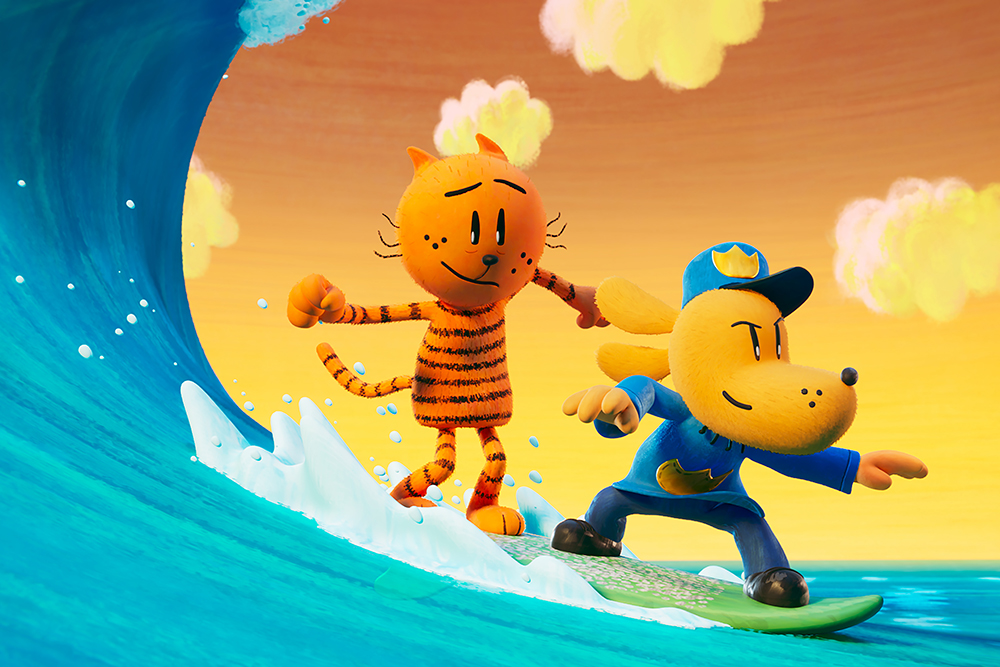
Q: The dynamic between Dog Man and Petey the Cat is central to the film. How did you use music to represent their rivalry and eventual alliance ?
Tom Howe: Well, I mean, for instance, there's a cue—Arresting Spy—in the early half of the movie, and it's a sort of two-and-a-half to three-minute montage. It's hopping between their different points of view, with Petey heading back to jail. I keep repeating the Dog Man motif every time he succeeds. So every time the handcuffs are about to go on Petey, or Dog Man has finally captured him, you get a little bit of his motif. And then, when Spy gets back in jail, it goes back to that kind of swing—so a swung upright bass with more of the alto flute sound.
So it stays in a kind of big band-esque world throughout the whole thing, but the jail moments are very much small forces. When Dog Man is on the scene, you get more of a full-on sound, and every time Dog Man makes an arrest, you get a quote of his tune. I reharmonize that in different ways underneath, but the melody always stays the same. That happens throughout the movie when they're fighting and together. As the movie progresses, they obviously become co—you know, they become friends and end up fighting together. In that instance, the sound becomes a bit more cohesive. But certainly, early on, I tried to distinguish them by having a big sound and a small sound with different melodies.
Q: What was the most challenging scene to score in Dog Man, and why ?
Tom Howe: I think probably the very opening, because I wasn't quite sure—I knew what I wanted it to be, but I wasn’t sure how far to lean into it being absolutely dead serious. So I kept adding in colors that were a little bit lighter, I suppose, and Peter very rightly pushed back on that. In the end, it sounds like it does now, where it's much more serious.
And then, another challenging one—I mean, they’re all challenging—but the Dog vs. Building cue has a ripsaw solo throughout, and it took a bit of thought to figure out what it should be and where it should rip. It's not an easy thing to program when you're doing a demo. That was pretty challenging too, but overall, the process was a pretty joyful one, really. It was lovely working with somebody who really knows music, which Pete, the director, does.
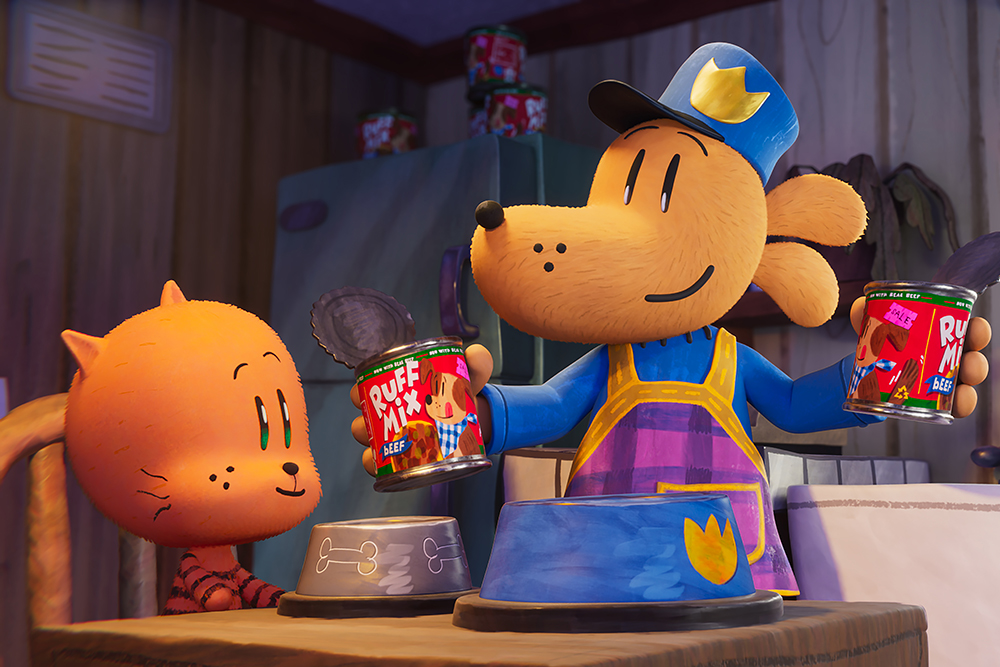
Q: Did director Peter Hastings or the animation team have specific musical references or ideas for the score, or were you given creative freedom ?
Tom Howe: I was given creative freedom, but a lot of what I did musically was definitely down to Peter and me talking and sharing ideas back and forth. I would do something, and he might then comment on it, either saying, "Well, that's going in the right direction," or that it wasn't. In terms of the animation team, there were a couple of cues in the movie—one of them being a TikTok dance when the lady at the Super Awesome Science Center's daughter made a homemade video. I had to write that before they animated it so they could synchronize the animation to the music. Similarly, for the piano cue Best Friends, where Lil' P and Dog Man play together, that had to be composed in advance so they could animate to it. That was quite challenging because I think the version in the final film might be my fifth attempt. There were a few rounds of adjustments since, at that point, I had no footage to work with. Writing music in a kind of vacuum, with only phone calls saying, "It should be X, Y, and Z, and it needs to be this long," made it difficult. I usually work best when I have something in front of me that I can use to tell a story, so that was particularly challenging—but ultimately, it turned out perfectly.
Q: The film is packed with action sequences and comedic moments. How did you navigate the rhythm and pacing of these scenes with your music ?
Tom Howe: The film is packed with action sequences and comedic moments, and navigating the rhythm and pacing of these scenes with music was an interesting challenge. Comedy is particularly tricky because I try not to write music that just sounds outright funny. Instead, I aim to compose music that stands on its own while addressing the comedy by either playing it completely straight or making it overly dramatic. For instance, if the scene is emotional but what’s being said is ridiculous, I might exaggerate the emotion to make it even more absurd. If it's an action sequence, I might make the action music over the top to highlight that the characters are only, say, fighting on a foosball table—yet scoring it operatically makes it funnier.
Another key technique is using breaks in the music. When a track plays continuously, inserting pauses or sudden stops can highlight comedic moments without needing to do anything overtly musical. The mere absence of music at the right moment can be very effective.
For action sequences, it's always about hitting the right cuts, movements, and timings. That means getting the tempo just right and ensuring that the score moves around both the dialogue and the action. This approach applies to any genre.
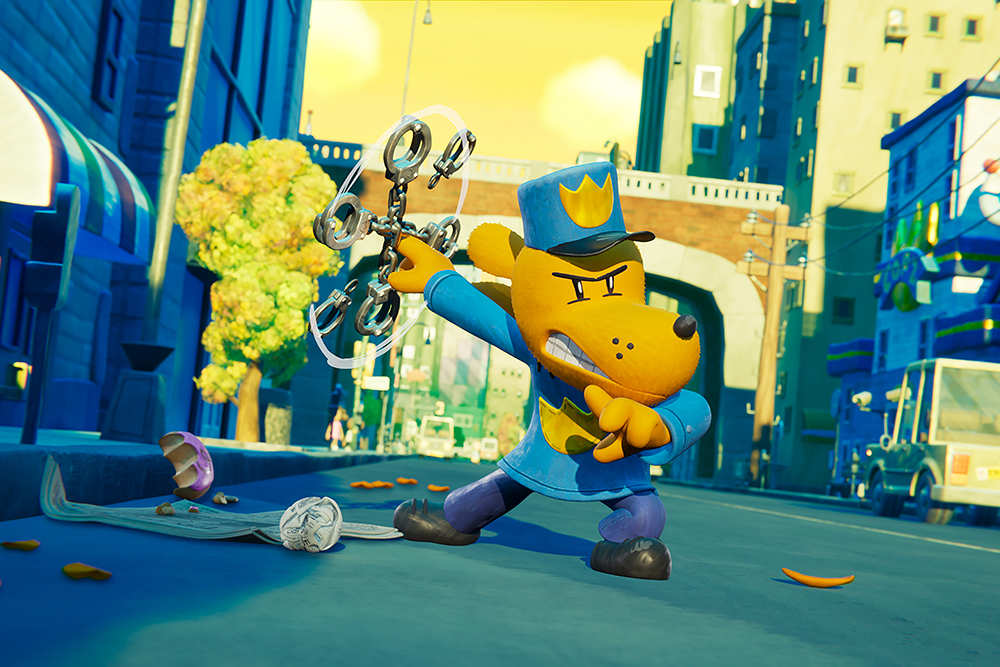
Q: Can you tell us about your recording process? Were there any unusual instruments or techniques used for this film ?
Tom Howe: I recorded electric guitars, mandolin, dog panting sounds, mouth trumpet, and various other soloistic elements here in my studio. Then, I was at Air Studios in London, where I spent two days recording with the orchestra.
Most film scores are recorded in a way that allows them to be separated, with strings, woodwinds, and brass recorded separately. But I don’t do that. I had the whole orchestra in the room playing together for two days at Air Studios—that was 76 players. Then, I had a day with a smaller orchestra, featuring solo woodwinds, a single horn, and a much-reduced string section.
After that, I had a day dedicated to a big band—saxophones, trumpets, and trombones. Then, I had a day where we recorded the band in the morning and the choir in the afternoon and evening. Finally, I had a very long day of percussion recording.
All those elements you hear in the movie were recorded live—there are no sampled elements. Sometimes, in films, you’ll find that percussion or other sounds are samples, but everything you hear in this score was actually played.
Q: Were there any fun or unexpected musical experiments that made it into the final score ?
Tom Howe: The dog panting was a fun one, and the mouth trumpet—both made it in. There's a sound for the Mayare, which is just a mandolin strummed very hard behind the neck. I was trying to think of something for her, and it had to be just one distinct sound, like the debris, which was just a one-note thing. I was wondering what it could be—something unique.
I did try quite a few other things that didn't make it into the film. I tried recording a load of squeaky dog toys, mapping them to a keyboard, and playing them—that was a terrible idea. I also tried some whistles and other things, but they didn’t work either. I even tried the kazoo, and that didn’t work. So, there was a lot of experimentation and messing around.
But certainly, the panting and the mouth trumpet are unusual sounds that made it in. There's also a lot of guitar in this movie—a lot of electric guitar playing under the action scenes. You don't always hear that in scores as they get bigger and bigger, but it’s a real throughline. It starts in the '70s funky world with WWA but carries on throughout. There are a lot of guitars in general, just playing through different sections.
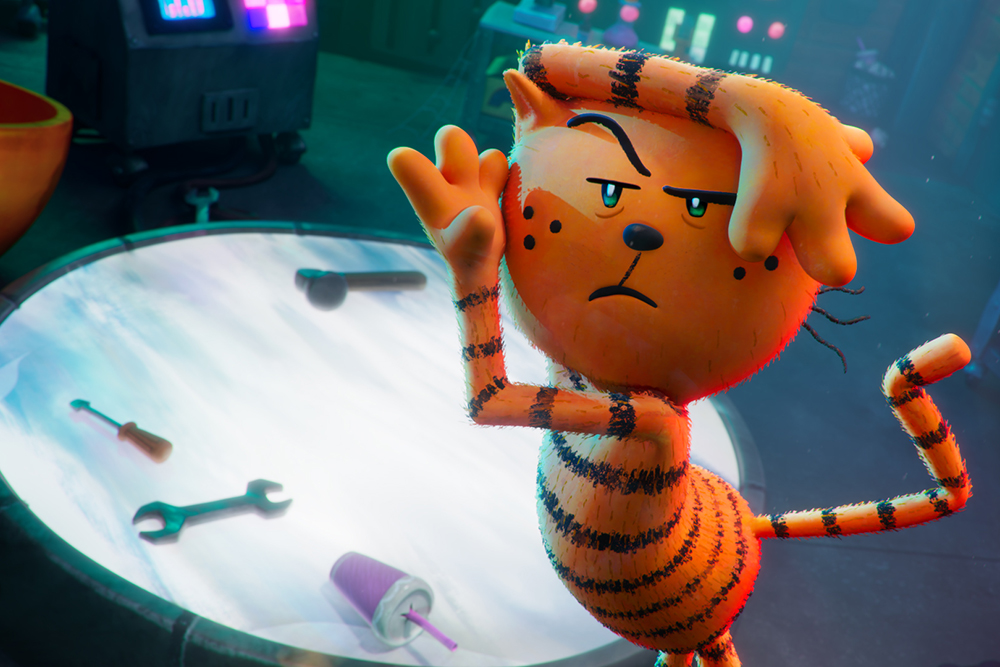
Q: Since Dog Man is a blend of heroic action and slapstick humor, how did you approach composing music that enhances both aspects ?
Tom Howe: Well, it's all picture-led, really. So, you know, if there's a moment where—I mean, there are a couple of moments in this where, for instance, the first time you see Dog Man, you see him playing the piano in the old folks' home, then you see him in the stadium throwing the baseball, and then you see them—these are tiny little musical moments. I mean, I'm talking maybe two or three seconds per section. And, you know, that's probably as close to slapstick as this movie gets. In terms of composition, I had to record those bits and then put them together, but there wasn't a lot of slapstick around that intentionally, apart from those sorts of moments. I tried to keep it playing straight, really. And then, yeah, the action certainly starts off in a much more big-band, uplifting, up-tempo style, and as the film progresses, it moves into a much darker orchestral tone, with those elements still kind of playing underneath.
Q: If you could have one of your compositions from Dog Man performed live with an orchestra, which piece would you choose and why ?
Tom Howe: I would probably choose Arresting Petey because everybody's having a turn, and it's completely bonkers. It would be quite interesting to try and conduct that in one go because there are some mad tempo changes, so it would need a bit of rehearsal, but I think it would be a lot of fun.
Award-winning composer Tom Howe continues to solidify his reputation as one of the most innovative and versatile musicians in the industry with his latest work on Dog Man. Known for seamlessly blending orchestral grandeur with modern and unconventional sounds, Howe brings a fresh, dynamic energy to the film’s score. His ability to capture the essence of a story through music is evident in Dog Man, where he uses inventive instrumentation—such as hand claps, funky brass, and even vocalized sound effects—to mirror the protagonist’s playful and chaotic nature. Drawing inspiration from classic crime thrillers while infusing contemporary funk and jazz elements, Howe crafts a soundtrack that is both nostalgic and refreshingly modern. His fearless experimentation, combined with a keen sense of rhythm and character-driven composition, ensures that Dog Man’s music is as much a storytelling tool as it is a feast for the ears. With an impressive résumé spanning projects like Ted Lasso, Daisy Jones & The Six, and The Legend of Tarzan, Tom Howe once again proves his ability to elevate a film’s emotional and comedic impact through sound.
Synopsis :
When a policeman and his faithful canine companion are both injured in the line of duty, a surgical operation as senseless as it is miraculous binds them together forever, giving birth to the one we'll now call Dog Man. Since then, he's been as dedicated to serving his country as he is to retrieving what's thrown at him, sitting up straight or rolling on the ground. He strives to prove himself under this new identity to better impress his superior, by putting an end to the exactions of the infamous Petey the Cat. Never short of bad ideas, the feline has recently found nothing better than cloning himself to double his capacity to commit crimes. But things get complicated when Lil Petey, his very young clone, falls into the clutches of a common enemy. To save the little kitten, dog and cat reluctantly join forces in a race against time. They discover that family ties can bring together even the most hostile enemies.
Dog Man
Written and directed by Peter Hastings
Based on Dog Man by Dav Pilkey
Produced by Karen Foster
Starring Pete Davidson, Lil Rel Howery, Isla Fisher, Poppy Liu, Stephen Root, Billy Boyd, Ricky Gervais
Edited by Brian Hopkins
Music by Tom Howe
Production company : DreamWorks Animation
Distributed by Universal Pictures
Release dates : January 15, 2025 (Festival de l'Alpe d'Huez), January 31, 2025 (United States), April 5, 2025 (France)
Running time : 89 minutes
Photos : Copyright 2024 DreamWorks Animation. All Rights Reserved.

